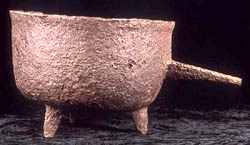In pre-Civil War times, plantation owners provided slaves with cheap, high-energy food—fatty pork bellies and starchy, unmilled corn. However, by adding a few dooryard crops, early-American Blacks came up with a remarkably nutritious diet, the cuisine known today as soul food, says George Estabrook, professor of ecology and evolutionary biology. Estabrook traced the origins and dietary implications of soul food in a public lecture Jan. 21 that also was part of his Biology 102 course, How People Use Plants.
For their dooryard gardens, Estabrook explained, the slaves chose plants that could tolerate heat and poor soil mature quickly and produce seeds for planting the next crop. It just happened that these plucky plants—turnip greens and black-eyed peas—also provided important nutrients. The greens were excellent sources of fiber and vitamins A and C, while black-eyed peas provided protein. The only drawback was that black-eyed peas were low in two essential amino acids (protein-building blocks that must be obtained from food because the human body cannot produce them). Fortuitously, corn provided those two amino acids. In addition, what corn lacked—adequate amounts of the essential amino acid methionine—black-eyed peas had plenty of, Estabrook says.
By boiling black-eyed peas, turnip greens, and pork fat in a single kettle and serving the mixture with grits made from home-ground corn, slaves cooked up meals that satisfied their dietary requirements, as well as their appetites. “When we look back at the diet that pre-Emancipation slaves were enduring, it gets some pretty high marks from our view as modern nutritionists, especially those black-eyed peas and turnip greens that the slaves grew themselves,” notes Estabrook.
Even the practice of grinding their own corn had benefits that did not become apparent until after the Industrial Revolution. Unlike its counterpart on today’s tables, the corn doled out to slave families had a tough seed coat, says Estabrook. Before it could be ground into meal or grits, it had to be soaked in an alkaline solution of ashes or crushed limestone and water, a traditional Native American practice that produces hominy. No one knew it at the time, but the soaking released bound-up niacin in the corn. Niacin is a dietary essential. After the slaves were freed and the country became more industrialized, Blacks went to work in mills and factories and began buying pre-ground cornmeal instead of soaking and grinding their own. Around the same time, thousands of low-income people started showing signs of pellagra, a potentially fatal disease with an unknown cause. Not until the 1930s was the discovery made that




